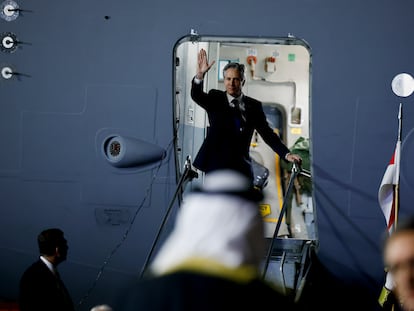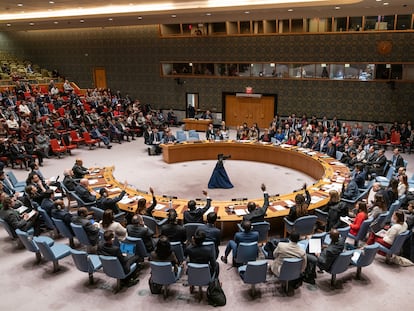Israel rejects Qatari plan to free hostages in exchange for allowing Hamas leaders to go into exile
Prime Minister Benjamin Netanyahu says that Israeli troops will not remain in Gaza after the war ends and that Palestinians will not be banished


The Israeli Security Cabinet presiding over the war in the Gaza Strip has rejected a proposal from Qatar, which is acting as a mediator in this conflict. The plan calls for freeing all hostages captured in Israel on October 7, in exchange for a cessation of hostilities and allowing the leaders of Hamas — the Islamist movement that has controlled the Gaza Strip for the past 17 years — to go into exile. In a meeting with Prime Minister Benjamin Netanyahu on Wednesday night, government ministers, senior military and intelligence officials discarded the Qatari plan for imposing the “unacceptable condition” of withdrawing troops and ending the fighting, according to reports in the Israeli press on Thursday.
The director of Mossad (Israel’s foreign intelligence service), David Barnea, presented the proposal he had received from Doha. Israeli political analysts believe that the plan reflects pressure from U.S. President Joe Biden, who sent his security advisor for the Middle East, Brett McGurk, to the Qatari capital. McGurk was already involved in the exchange of hostages for Palestinian prisoners that took place between November and December. Former Defense Minister and current member of the Security Cabinet, former general Benny Gantz, noted “that the most urgent thing is the return of the hostages, and that takes precedence over any military operation in the war.”
This week, a delegation of the relatives of 136 hostages being held in Gaza, dozens of whom may be dead or wounded, met with the Qatari authorities to urge more mediation. The rejected proposal envisaged the release of the hostages “in several phases” along with complete Israeli withdrawal from the Gaza Strip and allowing Hamas leaders in Gaza — including the political leader, Yahya Sinwar, and the military chief, Mohammed Deif — to go into exile. The Security Cabinet has flatly discarded a cessation of hostilities before the Israeli Defense Forces (IDF) achieve their objectives, especially the rescue of the hostages and the eradication of the Hamas command structure.
The Israeli press reports that Qatar has been mediating through top Hamas leader Ismail Haniyeh, who has lived in Doha for years, without coordinating with Sinwar. The leader in Gaza, who is considered to be the mastermind behind the attack in which 1,200 Israelis were killed three months ago, does not seem willing to accept going into exile or losing control over the organization inside Gaza. On Tuesday, Haniyeh warned that Israel will not secure the release of the hostages until it liberates the thousands of Palestinian prisoners convicted of “security crimes” in Israeli courts.
CIA Director William Burns remains in contact with the Qatari authorities mediating the release of the hostages in Gaza. Meanwhile, in Cairo, Israel has set up another negotiating center for the rescue of the hostages. In the coming days, the Israeli army is expected to authorize the entry of 400 trucks a day into the Gaza Strip through the Rafah border crossing with Egypt to deliver humanitarian aid, twice as many vehicles as allowed now. During his recent visit to Tel Aviv, U.S. Secretary of State Antony Blinken received assurances of an increase in the delivery of international aid to the Gazan civilian population. In Egypt, the last stop on his Middle East tour, Blinken insisted that Israel must allow civilians displaced by the war to return to their homes in the Gaza Strip “as soon as conditions permit.”
A few hours before the start of the U.N. International Court of Justice hearing in The Hague, where South Africa is accusing Israel of having violated the convention on genocide in the Gaza Strip, Netanyahu stated that the army “has no intention of occupying Gaza permanently or of banishing its civilian population.” Thus, the prime minister has come out against statements by radical members of his government, who have called for reestablishing Jewish settlements and the removal of the Palestinian population from the area. “We are doing everything possible to minimize [the number] of civilian casualties,” he emphasized in an official statement.
Traces of hostages in a tunnel
On Wednesday night, IDF chief spokesman Rear Admiral Daniel Hagari said that troops had located a tunnel in the Khan Yunis area (in the southern Gaza Strip), where several hostages had been held captive. “The release of the hostages requires our best efforts. We have carried out operations to rescue them that we have not reported and others we have suspended at the last moment,” Hagari revealed. According to the Efe news agency, relatives of the hostages gathered with loudspeakers at the border fence between Israel and Gaza to demand their immediate release.
The army is continuing its offensive in central and southern Gaza, and the territories are under heavy bombardment. As of midday Thursday, the enclave’s Health Ministry put the daily death toll at 112 dead, bringing the total to nearly 23,500 since the war started. In northern Gaza, only three of the 21 humanitarian aid shipments scheduled by the United Nations have been completed since 2024 began, either because of Israeli security controls or because many roads are impassable. Military spokesmen said that fighting is taking place “underground and above ground.” The IDF report that they have found 300 tunnel openings and demolished dozens of underground passages.
This Thursday, with the tension between Israel and Hezbollah on the Lebanese border seeming to ease in the past few hours, U.S. mediator Amos Hochstein traveled to Beirut to try to contain the clashes between the Shiite militia and the Israeli army. In 2022, Hochstein mediated the pact through which Lebanon and Israel fixed the demarcation of their maritime border to allow for the extraction of gas fields in the eastern Mediterranean.
Sign up for our weekly newsletter to get more English-language news coverage from EL PAÍS USA Edition
Tu suscripción se está usando en otro dispositivo
¿Quieres añadir otro usuario a tu suscripción?
Si continúas leyendo en este dispositivo, no se podrá leer en el otro.
FlechaTu suscripción se está usando en otro dispositivo y solo puedes acceder a EL PAÍS desde un dispositivo a la vez.
Si quieres compartir tu cuenta, cambia tu suscripción a la modalidad Premium, así podrás añadir otro usuario. Cada uno accederá con su propia cuenta de email, lo que os permitirá personalizar vuestra experiencia en EL PAÍS.
¿Tienes una suscripción de empresa? Accede aquí para contratar más cuentas.
En el caso de no saber quién está usando tu cuenta, te recomendamos cambiar tu contraseña aquí.
Si decides continuar compartiendo tu cuenta, este mensaje se mostrará en tu dispositivo y en el de la otra persona que está usando tu cuenta de forma indefinida, afectando a tu experiencia de lectura. Puedes consultar aquí los términos y condiciones de la suscripción digital.
More information
Archived In
Últimas noticias
Most viewed
- Reinhard Genzel, Nobel laureate in physics: ‘One-minute videos will never give you the truth’
- Oona Chaplin: ‘I told James Cameron that I was living in a treehouse and starting a permaculture project with a friend’
- Pablo Escobar’s hippos: A serious environmental problem, 40 years on
- Why we lost the habit of sleeping in two segments and how that changed our sense of time
- Chevy Chase, the beloved comedian who was a monster off camera: ‘Not everyone hated him, just the people who’ve worked with him’










































